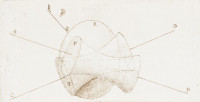Engine for grinding hyperbolic glasses and a salt-works, Cheshire
Date
1669
Creator
Unknown, Engraver
Creator - Organisation
The Royal Society, Publisher
Object type
Article identifier
Material
Technique
Dimensions
width (paper): 355mm
height (paper): 470mm
height (paper): 470mm
Subject
Content object
Description
Seven figures to issue 53 of the Philosophical Transactions of the Royal Society including an engine for grinding hyperbolic glasses and a salt-works, Cheshire.
Illustration of an engine for grinding hyperbolic glasses designed by Christopher Wren. This follows on from Wren's publication in Philosophical Transactions of the Royal Society, vol. 4, issue 48 (1669), which shows that a section through the axis of a cylinder was a hyperbolic surface, which could then be applied to create a machine to grind hyperbolic lenses.
Fig I-VI Six figures of a salt-works at Nantwich, Cheshire, including an iron pan used for boiling brine water, a cross-section of the hot house with chimney, wooden apparatus for extracting brine water from a ship, two loots used for skimming and gathering salt, two barrows for straining salt and a gutter for filling the pans with brine water.
Illustration to A description of Dr. Christopher Wren’s engin, designed for grinding hyperbolical glasses; as it was in a manner promised numb. 48. p. 962 published in Philosophical Transactions of the Royal Society, vol. 4, issue 53, pp.1059-1060 (15 November 1669). Read to the Royal Society on 10 June 1669 the original paper can be found in the Classified Papers of the Royal Society CLP/1/11.
Fig I-VI Illustration to Some inquiries concerning the salt-springs and the way of salt-making at Nantwich in Cheshire; answer'd by the learned and observing William Jackson Dr. of Physick published in Philosophical Transactions of the Royal Society, vol. 4, issue 53, pp.1060-1067 (15 November 1669). The original letter can be found in the Early Letters of the Royal Society EL/I1/159 and recorded in the Register Book RBO/4/24 without illustrations.
Christopher Wren was elected a Fellow of the Royal Society in 1660, he served as its President from 1680 to 1682. Wren was a founder of the Society.
Illustration of an engine for grinding hyperbolic glasses designed by Christopher Wren. This follows on from Wren's publication in Philosophical Transactions of the Royal Society, vol. 4, issue 48 (1669), which shows that a section through the axis of a cylinder was a hyperbolic surface, which could then be applied to create a machine to grind hyperbolic lenses.
Fig I-VI Six figures of a salt-works at Nantwich, Cheshire, including an iron pan used for boiling brine water, a cross-section of the hot house with chimney, wooden apparatus for extracting brine water from a ship, two loots used for skimming and gathering salt, two barrows for straining salt and a gutter for filling the pans with brine water.
Illustration to A description of Dr. Christopher Wren’s engin, designed for grinding hyperbolical glasses; as it was in a manner promised numb. 48. p. 962 published in Philosophical Transactions of the Royal Society, vol. 4, issue 53, pp.1059-1060 (15 November 1669). Read to the Royal Society on 10 June 1669 the original paper can be found in the Classified Papers of the Royal Society CLP/1/11.
Fig I-VI Illustration to Some inquiries concerning the salt-springs and the way of salt-making at Nantwich in Cheshire; answer'd by the learned and observing William Jackson Dr. of Physick published in Philosophical Transactions of the Royal Society, vol. 4, issue 53, pp.1060-1067 (15 November 1669). The original letter can be found in the Early Letters of the Royal Society EL/I1/159 and recorded in the Register Book RBO/4/24 without illustrations.
Christopher Wren was elected a Fellow of the Royal Society in 1660, he served as its President from 1680 to 1682. Wren was a founder of the Society.
Related fellows
Christopher Wren (1632 - 1723, British) , Architect
Associated place
